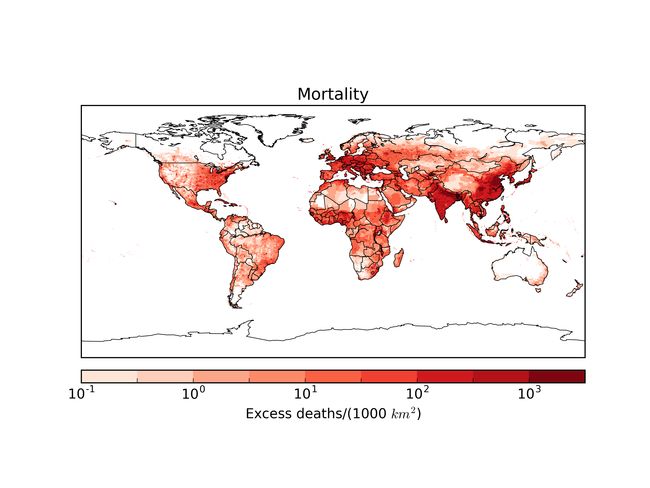
World Faces Air Pollution Threat, and Light Technology Could Help
MAINZ, Germany, March 5, 2020 — Researchers in Germany believe air pollution is responsible for 8.8 million deaths per year, according to a study published March 3 in Cardiovascular Research. However, research by SPECTARIS, the Fraunhofer Institute, TEMATYS, and Messe München suggests that by 2030, photonic technology applications could lessen worldwide CO2 output by 3 billion tons.

Years of life lost from air pollution (units per 1000 km2). The global total is 233 million per year. Courtesy of Jos Lelieveld.
Professors Jos Lelieveld and Thomas Münzel of the Max Planck Institute for Chemistry and the Department of Cardiology of the University Medical Centre Mainz in Mainz, Germany, said their findings on air pollution suggest the world is facing a pandemic.
The researchers estimated that air pollution caused an extra 8.8 million premature deaths globally in 2015. This represents an average shortening of life expectancy of nearly three years worldwide. To find these results, the researchers used a new method of exposure data from a model that simulates atmospheric chemical processes and the way they interact with land and sea and chemicals emitted from natural and human-made sources. Next, they applied these to a new model of global exposure and death rates and to data from the Global Burden of Disease, which included information on population density, geographical locations, ages, risk factors for several diseases, and causes of death.
The researchers looked at the effect of air pollution on six categories of disease: lower respiratory tract infection, chronic obstructive pulmonary disease, lung cancer, heart disease, cerebrovascular disease leading to stroke, and other, noncommunicable diseases, which include conditions such as high blood pressure and diabetes.
The research showed that cardiovascular diseases are responsible for the greatest proportion of shortened lives from air pollution: 43% of the loss in life expectancy worldwide. It also showed that air pollution had a greater effect on shortening lives in older people, with about 75% of global deaths attributed to air pollution in people older than 60.
“It is remarkable that both the number of deaths and the loss in life expectancy from air pollution rival the effect of tobacco smoking and are much higher than other causes of death,” Lelieveld said. “Air pollution exceeds malaria as a global cause of premature death by a factor of 19; it exceeds violence by a factor of 16, HIV/AIDS by a factor of 9, alcohol by a factor of 45, and drug abuse by a factor of 60.”
“Policymakers and the medical community should be paying much more attention to this,” Münzel said. “Both air pollution and smoking are preventable, but over the past decades much less attention has been paid to air pollution than to smoking, especially among cardiologists.”
The researchers estimate that if air pollution was reduced by removing fossil fuel emissions, the average life expectancy worldwide would increase by just over a year, and by nearly two years if all human-made emissions were removed.
According to research from SPECTARIS, the Fraunhofer Institute, TEMATYS and Messe München, a larger pivot to light technologies may provide solutions for environmental sustainability and climate protection.
The study showed that in 2019, eight examples of photonics technologies resulted in an indirect contribution of 1.13 billion tons CO2 equivalent. These technologies included energy-efficient lighting, fiber optic network communications, optical detection of forest fires, photovoltaics, optical communication in data centers, energy-efficient displays, laser-supported metal recycling, and optical communication in 5G mobile networks.
“Photonics has made it possible to identify the hazards of climate change,” said Bernhard Ohnesorge, chairman of the Photonics Trade Association SPECTARIS. “What matters now is that we make sure to use these opportunities wisely.”
“Photonics makes it possible to constructively combine economy and environmental protection,” said Reinhart Poprawe, former director of the Fraunhofer Institute for Laser Technology ILT/RWTH Aachen University. “This is achieved by both increasing the efficiency of manufacturing processes and producing optimized components for Germany’s transition to renewable energy, particularly through precision work using ultrashort pulse lasers or by using additive manufacturing processes.”
/Buyers_Guide/Fraunhofer_FEP/c32119